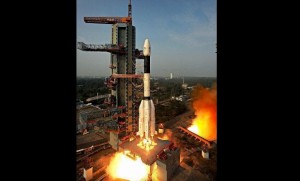It was a proud moment for all Indians when Indian Space Research Organization’s (ISRO’s) GSLV-DF rocket cruised through the Earth’s atmosphere to successfully place GSAT-14 communications satellite into the orbit on Sunday.
Powered by an indigenous cryogenic engine, it injected into orbit a telecommunication satellite, GSAT-14, with clockwork precision. The launch was extremely precise and ensured that the satellite reached 40m within the targeted perigee (nearest point from Earth) of 179km and only 50km from the 36,000km apogee (farthest point from Earth).
“All the stages of GSLV-D5 performed as planned,” said ISRO chairman K Radhakrishnan. “The mission is a success. We dedicate this proud moment to the country,” he added. With this, India has become the sixth spacefarer after US, Russia, the European Space Agency, China and Japan to develop a cryogenic engine — a prerequisite for interplanetary probes and manned space missions.
The Rs 356 crore mission’s success comes as a big relief for ISRO after two back-to-back failures of the GSLV flights in 2010 — the first, with an indigenous cryogenic engine, on April 15 and the next, with a Russian cryogenic engine, on December 25. The last GSLV launch on August 19, 2013 was called off minutes before the take-off due to leakage of liquid fuel from the rocket’s second stage, wetting the first stage and the four strap-on boosters around it.
All about the GSLV: Geosynchronous Satellite Launch Vehicle (abbreviated as GSLV) is an expendable launch system operated by the Indian Space Research Organization (ISRO). It was developed to enable India to launch its satellites indigenously without dependence on foreign aid. GSLV has attempted eight launches to date, since its first launch in 2001 through its most recent launch in 2014. Three launches have been successful, four have failed, and one was a partial failure, placing the satellite into an unplanned, but recoverable, orbit. The most recent flight, GSLV-D5 was launched successfully on 5 January 2014 during its second attempt.
A cryogenic engine is more efficient as it provides more thrust for every kilogram of propellant burnt. Cryogenic fuels are extremely clean as they give out only water while burning.




0 Comments